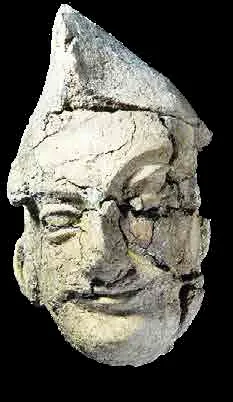The earliest examples of ancient art in the Museum are clay sculptures found on the site of Khalchayan, near the town of Denov in the Surxondaryo region, which was once part of ancient Bactria. Employees of the Uzbekistan Expedition for Art Study, created and headed for many years by the outstanding architect and art historian G. A. Pugachenkova, studied the palace of Kushan rulers in Khalchayan in the years 1959 – 1963.
The reception chamber and iwan of the palace were decorated with sculptural decor, designed to glorify the military achievement and majestic image of a young dynasty, to show its representatives as severe warlords, contending for the land of Bactria, and as hospitable lords at feasts in honour of their great victories. There are 32 sculptural works in the Museum that decorated the chamber and the iwan. They reflect the diversity of the characters of the sculptural composition of the palace: the ruler and his wife; the victorious prince with the spoils of war – armour taken from the enemy; statues of deities – patrons of the dynasty; captive soldiers; as well as participants of the feast – a Parthian prince, court ladies, musicians and boys with garlands. The honour of the discovery, study, historical and cultural interpretation and publication of materials on the sculpture of Khalchayan belongs to G. A. Pugachenkova, as well as to the team of archaeologists and restorers whose hard work extracting and securing hundreds of fragile fragments of clay can be called a true scientific achievement. Thanks to them, the world saw the first examples of Kushan art embodied in clay and not limited to the strict framework of the Buddhist canon. It is this exceptionality of the Khalchayan findings that aroused the genuine interest of specialists all over the world.
Careful iconographic analysis allowed G. A. Pugachenkova to compare the Khalchayan sculpture portraits with the image of the Kushan ruler “Heraios/Sanab/Kushan” on coins and name the representatives of the ruling clan embodied in the sculpture the descendants of Heraios. She detailed the artistic style of the works, which was the result of the further development of the Hellenistic tradition of portrait art and its adaptation to local aesthetic needs and the needs of local monumental propaganda.
In the relief decoration of the palace are also Athena and Heracles. In spite of a certain “barbarization” in the appearance of the characters of the Greek pantheon, they are quite recognizable, but we must remember that the iconography of Greek gods and heroes was gradually adapted to transmit the image of local deities. Therefore, the image of the Zoroastrian goddess Rishto/Arshtat later occurs on Kushan coins, but according to the iconography, it is Athena.
In the image of a mighty Heracles, they began to depict Verethragna, one of the Zoroastrian deities who was a victor over evil forces and the paragon of courage. From the arrival of the Yuezhi to Bactria in about 130 BC until the middle of the 1st century AD when the decor of Khalchayan was created, that is, over about 180 years, the ideology of the nomads who came from the borders of China was significantly transformed. Judging by the images on the Great Kushan coins, they embraced the local Zoroastrian pantheon.
Therefore, in Khalchayan, with Athena and Heracles interpreted as patron deities of the Heraios dynasty, we should not see the actual Greek gods, but local ones embodied in the Hellenized form.
You can learn more about this topic in the book-album “The Collection of the State Museum of Arts of Uzbekistan” (Volume XIII) from the series “Cultural legacy of Uzbekistan in the world collections”.
The general sponsor of the project is the oilfield services company Eriell-Group.



